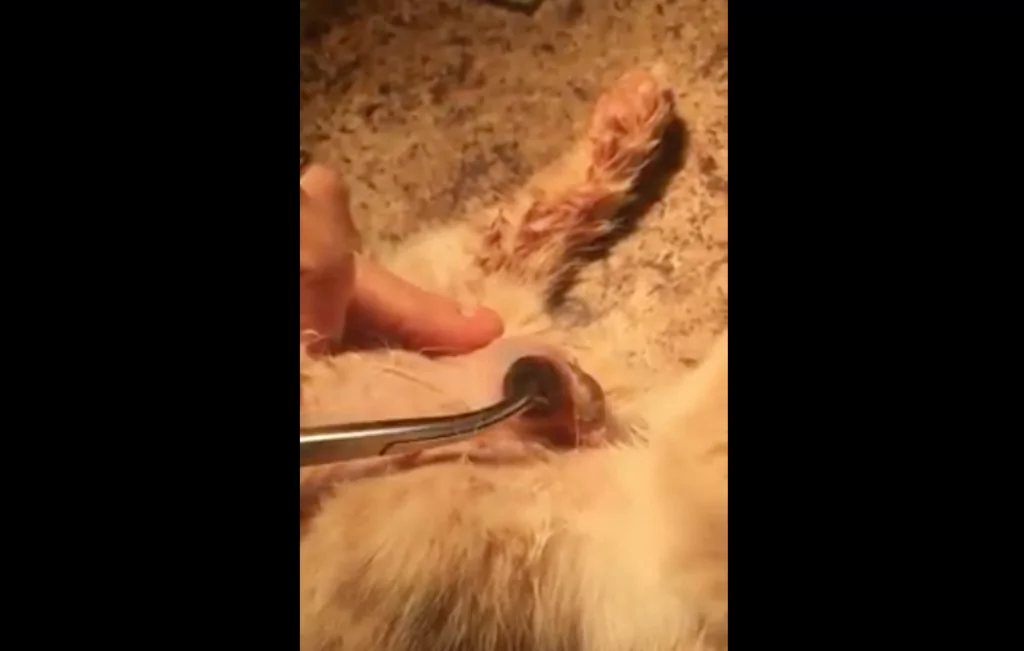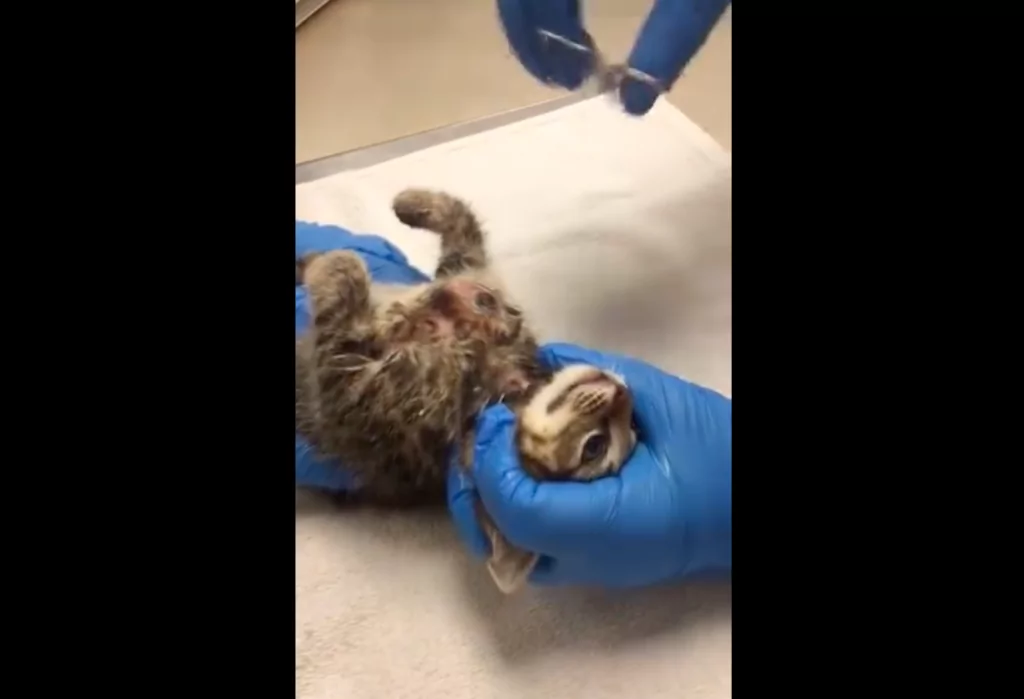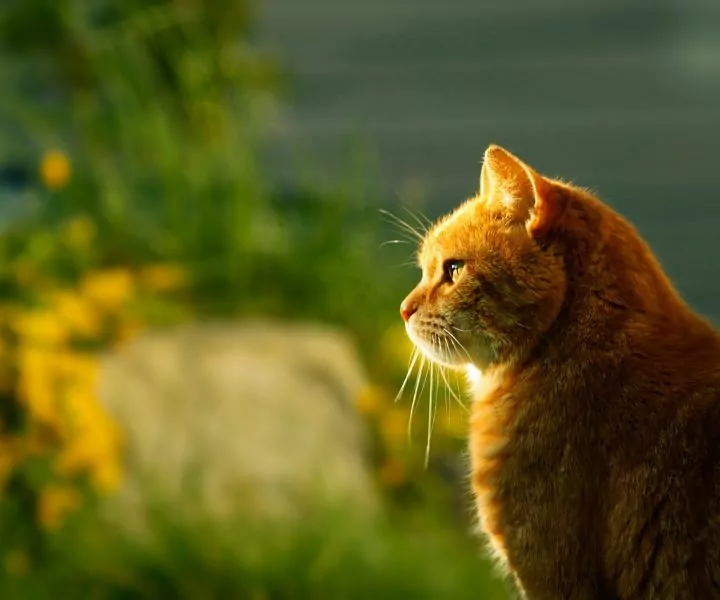What is a Wolf Worm in Cats?
Warbles in cats are, luckily, a rare condition. But, no matter what, no owner wants to see a red thing sticking out of a cat’s nose or anywhere else. However, that is precisely what happens with the wolf worm – a condition also known as cat warbles. The larva of the botfly, the wolf worm, buries itself in a warble hole on the cat and, in time, turn into an adult botfly!
Now you may be wondering, “can humans get warbles from cats?” and what are the wolf worm symptoms in cats? Keep reading to find out!

Where Do Warble in Cats Manifest Themselves?
The warble worm, in theory, manifest itself anywhere on our cats – and other small animals. The wolf worm in the cat’s nose is most common, as this is the area most likely to be exposed to the eggs and larvae on cats.
That said, larvae aren’t too picky. Anything with body heat will cause the wolf worms to hatch, and any skin or orifice can serve as the perfect growing spot. Meaning botfly holes on cats’ necks is also relatively common, along with the paws and even the belly area.
Wolf Worm Symptoms in Cats
If you live in an area where botflies are common, and you ever find yourself thinking, “my cat has a hole in his skin,” you would be right to suspect a cat warble. You should seek veterinary care for your kitten.
Cat warble symptoms can look relatively benign. Especially in the early stages, where you might not even be able to see the wolf worm but only suspect the general wolf worm location on the skin.
That said, there are some early-stage symptoms of wolf worm in cats you can look out for on the skin:
- Red swelling of the skin with a hole in the cat’s skin on the top of the swelling.
- Foul-smelling discharge from the hole.
If your cat is suffering from a wolf worm present on its nose, other frequent symptoms include:
- Cat sneezing.
- Nasal discharge.
- Swelling of the nasal area.
- Feline Coughing.
It is also likely your cat’s general well-being will be affected by the presence of a wolf worm somewhere on the body. Especially as the wolf worm develops, many cats also start to suffer from decreased appetite and activity levels.
In some, luckily rare cases, wolf worms in the cat’s necks can bury themselves further in the cat, eventually leading to the spinal cord and even the brain. In these cases, symptoms will often be very acute and can involve:
- Blindness.
- Lack of coordination.
- Seizures.
- Head tilt.
- Walking in circles.
- Behavioral changes.
Neurological symptoms are thankfully rare. Nonetheless, suppose you suspect your cat is carrying a wolf worm. In that case, you should contact your local veterinary care provider as soon as possible.
What Does a Wolf Worm Look Like?
You may also be wondering,” what is a wolf worm?” or maybe:” What is a warble on a cat?”. Let’s go back to scratch on this one.
A botfly is a large type of fly native to especially central America. However, you can also find it in North America. The adult botfly will lay its eggs, and larvae will develop from them. Due to their parasitic nature, the larvae are called wolf worms and are a type of maggot.
When the wolf worm burrows itself into the skin of a mammal, the swollen area is then called a “warble”. Wolf worms in cats are simply what causes the disease warbles. Sometimes the wolf worms are therefore also referred to simply as “warbles.”
Wolf worms are gray-reddish worms approximately 0.32 inches (1 centimeter long) and almost as wide, with an overall oval shape. They will eventually be close to 1 inch (2.5 centimeters) as they grow.
How Do Cats Get Larvae in Their Noses?
So, should you kill it on sight every time you see a botfly on cat skin? We understand why you may think that, but unfortunately, it is not that easy.

A botfly larva, or a wolf worm, will bury itself into the skin to develop into a fly. Luckily, they cannot enter the skin everywhere. The larvae can only access the deeper tissue layers of the skin through a wound, cut in the skin, or through an orifice – which is how they get into the nose.
Cats use their nose to explore the world around them, almost as much as dogs. However, cats also use their impressive eyesight to spot predators and prey. When a cat comes by a rabbit burrow, where botfly eggs are, they will enter the area headfirst (unsurprisingly) and their nose close to the ground.
This allows the eggs to stick to the fur around the nasal area and openings. Once they hatch, the larvae can enter the skin through the nasal orifice. This is why a wolf worm fly in cats are often found on the nose or facial region – or even inside the nose if your cat is unlucky!

Causes of Warbles in Cats
Warbles are the condition when the wolf worm enters the skin of a small mammal to develop into a grown maggot, which will eventually be a botfly. But how does this cat wolf worm botfly symbiosis start?
When an adult botfly lays its eggs, it will often do it in tall grass close to the burrow of a small animal within a field or forest area. These small mammals are often rodents or in some cases, wolf worm in rabbits, but they can also be cats just passing by – or small dogs. When the mammals pass the eggs, the eggs will stick to the fur.
After a short period, the eggs will sense the body heat from the mammal, which will lead to the eggs hatching. The wolf worm larvae appear – now it is called a maggot. The wolf worm will crawl around on the skin until they find an orifice, often the ear, nose, mouth, or eyes.
The cat wolf worm will migrate through the tissues until they reach the skin, which they need to ensure that they have a breathing hole throughout their development time. Within the skin, the wolf worm establishes itself within the “warble” – the lump in the skin.
The good news is that once the wolf worm fully matures, it will drop from the host, form a pupa in the soil and eventually emerge as an adult botfly. However, that can take up to six weeks in some cases. Until then, your cat will be the carrier of the wolf worm maggot.
Diagnosing Wolf Worm in Cats
Wolf worm is not a common disease, but your veterinarian will know which symptoms to look out for. Often a consultation will start with a thorough clinical examination.
If your cat has any respiratory signs, like nasal discharge or sneezing, the nose will often be the place to look first. Your vet will also evaluate any other area of the skin, but also within the mouth, throat, and similar orifices, to look for signs of warbles.
If symptoms are severe and no warble is not visible, it may be helpful to do a CT scan. It is, however, rarely necessary as the wolf worm can often be found within its warble and is easy to spot once symptoms appear.
Treating Warbles in Cats
The first step of treating warbles or wolf worms in cats is to remove the larvae. Sometimes they are large enough to pluck them from the skin easily. Other times it is necessary to use tools like a scalpel to make an incision in the warble and then use tweezers to get it out.
The wolf worm can entirely stick within the warble, so most cats may need mild sedation and painkillers to ensure they lie still and the whole wolf worm can safely come out.
Once removed, the critical part is cleaning the wound thoroughly to minimize the risk of infection. If an infection is already present, cleaning may be necessary with animal antibiotics.
We do not recommend that you attempt to remove the wolf worm at home. If it is almost fully grown, you can perhaps do it. Still, you risk leaving pieces of the wolf worm within the warble, which can lead to severe inflammation and risk of infections.
How to Prevent Wolf Worm in Cats
The only way to prevent wolf worm in cats is to keep your cat indoors or only allow it outdoors when supervised.
Whether this is a solution for you and your cat will very much depend on the area you live in. As well as the region of the world. In most of America, it is considered the norm to keep cats indoors, whereas, in most of Europe, it is the norm to let cats roam freely outside. Both have their advantages and disadvantages.
If you let your cat outdoors, the best thing you can do is to frequently examine it at home for wolf worms and warbles and take it for frequent veterinary checkups to ensure you catch any complications early on.

Cuterebra Complications in Felines
In rare cases, the infestation of a wolf worm maggot can cause systemic inflammatory reactions within the cat. This reaction can worsen symptoms and cause your cat to become lethargic (tired) and even at the risk of shock-like conditions. If this happens, your cat will need extensive veterinary care and, most likely, hospitalization.
Similarly, suppose the wolf worm is lodged within the eye or near the central nervous system (e.g., the spinal cord). In that case, the prognosis is more severe, and intensive care is necessary. Care is needed to ensure the inflammation does not affect the brain or other vital parts of the body.
In most cases, the wolf worm warble is a localized reaction in the skin. It can be sorted out with painkillers and antibiotics, if necessary.
Can Humans Get Warbles From Cats?
Once inside the skin, the wolf worm cannot migrate from one place to another. It will die if it falls out before it is a fully matured maggot, ready to pupa in some soil. Therefore, you should not worry that your cat can transmit the wolf worm from its skin to you.
However, although rare, it is not unheard of for wolf worms to attempt to bury themselves in human skin. We humans do not have as much fur as mammals the eggs can stick to, but in some cases, the hair we do have is enough. Don’t worry, though; if you stay clear of rabbit burrows, you should be fine!

The Word is Out!
No one wants to see a wolf worm in cats; even people who aren’t too fussy about insects can react when they see an inch-long maggot developing within the skin of their furry friend. But you must seek veterinary care for your cat as soon as possible if you suspect it is suffering from warbles.
It will give your cat the best chances of a speedy recovery, with fewer complications, and back to exploring in no time at all!
